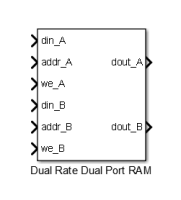Dual Rate Dual Port RAM
Dual Port RAM that supports two rates
Libraries:
HDL Coder /
HDL RAMs
Description
The Dual Rate Dual Port RAM block models a RAM that supports simultaneous read and write operations to different addresses at two clock rates. Port A of the RAM can run at one rate, and port B can run at a different rate.
In high-performance hardware applications, you can use this block to access the RAM twice per clock cycle. If you generate HDL code, this block maps to a dual-clock dual-port RAM in most FPGAs.
Simultaneous Access
You can access different addresses from ports A and B simultaneously. You can also read the same address from ports A and B simultaneously.
However, do not access an address from one RAM port while it is being written from the other RAM port. During simulation, if you access an address from one RAM port at the same time as you write that address from the other RAM port, the software reports an error.
Read-During-Write Behavior
The RAM has write-first behavior. When you write to the RAM, the new write data is immediately available at the output port.
Ports
Input
Output
Parameters
Algorithms
Extended Capabilities
Version History
Introduced in R2014a
